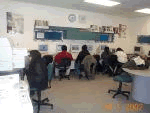|
|
The Kuh-ke-nah Network
of SMART First Nations is a practical expression of Indigenous
community development. Six First Nations - connected by water
in the summer and ice in the winter - have built an electronic
road to Canada and the world. We are using this resource to
stimulate and manage change in our communities.
The broadband network
is both a strategy and an outcome. SMART services are being
deployed to overcome barriers of distance and isolation, to
improve community well-being, enhance learning opportunities,
and support skills and knowledge acquisition. The Kuh-ke-nah
Network is a touchstone for Keewaytinook Okimakanak First
Nations and a promising means for building sustainable communities
in the 21st Century.
Kuh-ke-nah is for
and by everyone. It is a shared resource with deep roots in
Deer Lake, Fort Severn, Keewaywin, McDowell Lake, North Spirit
Lake and Poplar Hill. Since its inception as 'K-Net' almost
seven years ago, the Kuh-ke-nah Network has grown from a regional
bulletin board service to a centre of expertise in Indigenous
informatics.
|
New Ways
of Doing Business in First Nations - Being Smart
First Nations
are using computers, digital cameras, scanners, printers,
video conferencing and other tools to share information
and communicate with the other people around the world.
These information and communication technologies or ICTs,
as they are called, are changing the way people work and
do business across the region. They are doing things the
"smart" way.
Other First
Nations with the proper communication connections and
tools across Nishnawbe Aski Nation are now sharing their
stories, pictures and other information about the people,
the families, the businesses, the land, the resources,
the opportunities and the struggles. This information
is helping people to better understand many of the opportunities
and issues facing this region.
These new
tools or ICTs are changing the way First Nations can
receive and deliver services. With the proper connections
and tools, anyone can teach a course, sell their artwork
or crafts, meet with other people, tell stories, find
out information just about anything, learn about other
communities and people.
|
 |
 |
|
| KO Telehealth:
New Service Getting Ready to Improve Community Access
to Healthcare Visit
Website |
Four years ago.
That's when the Keewaytinook Okimakanak Chiefs saw for the
first time what telehealth could do for their communities.
They were at the Ottawa Heart Institute watching a videoconference
between a Cardiologist and a patient in the Northwest Territories.
They listened to
a heart beating in a clinic thousands of kilometres away and
they saw first hand how timely access to telehealth improved
personal and community well-being. That's when the telehealth
vision was formed. Joe Meekis, chief of Keewaywin First Nation
at the time, asked, "why is this equipment and service
not in our health clinic today?" Read
more...
|
|
If you stay in
the north, how do you ever get to meet people from other places?
You meet them online, of course.
Learning at home
is what youth in KiHS classrooms have chosen to do. Rather
than leaving their families and "going away" to
school, they are staying at home to work. KiHS (the Keewaytinook
Internet High School) and their community leaders are helping
them have this choice.
The community KiHS
classroom is a space identified by community leaders. It is
"wired" for Internet access, and is staffed by a
trained teacher and a community computer technician. One of
the student's courses is taught by the onsite teacher, - although
the lessons come to the students via the Internet. Other KiHS
teachers in similar First Nation classrooms teach the other
courses that a KiHS student takes. Read
more...
|


